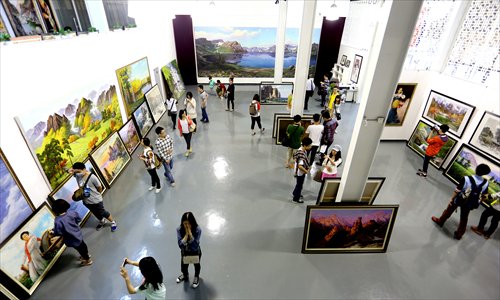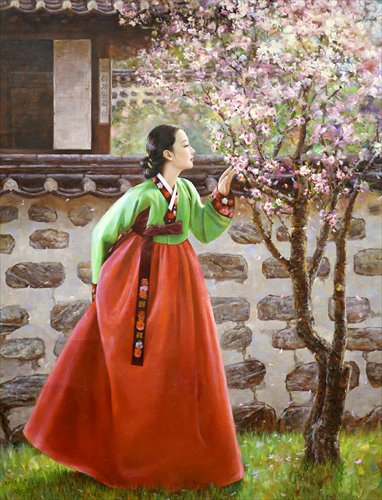Pyongyang’s creations

People visit the Korea Traditional Art Center in early May. The museum receives over 300 visitors per day. Photo: Courtesy of KTAC
Hu Yaozhong, the director of the Jinzhao Art Museum, had a hasty lunch in a fast-food restaurant and quickly returned to the Shengshi Sky gallery in Beijing's trendy 798 Art Zone.
He had flown into Beijing from Dandong, Liaoning Province, bordering North Korea, two days earlier, and has scarcely had a moment's rest since, because he has been busy organizing an exhibition of North Korean artworks that will go on display on May 24.
He guesses that the gallery will receive upwards of 200 visitors each day. He also optimistically expects that all the paintings will be sold.
"North Korean paintings are hot in China. People, whether they are art fans or collectors, are interested in North Korean art, because of its mystery and purity," Hu, who is based in Dandong but anticipates expanding art sales in Beijing, told the Global Times.
Like everything else in the reclusive country, contemporary art in North Korea is scarcely known to the outside world. North Korean paintings had never officially entered the Chinese market until in 2007, when an auction of North Korean paintings sold a majority of the works on display.
Hu has been collecting North Korean paintings for over a decade. He used to collect Chinese contemporary artworks, but after he accidentally saw North Korean paintings, he "fell in love with them" and invested 5 million yuan ($800,000) to set up a gallery in 2006 to promote the art.
Hu is not alone. In many cities and provinces, galleries and museums that are authorized to sell and market North Korean paintings by cooperating with Pyongyang have sprung up in recent years. In the 798 art zone, for instance, there are two galleries, the Mansuda Art Center and the Korea Traditional Art Center (KTAC), which are focused on North Korean paintings.
In some cities like Yiwu in Zhejiang Province, Dandong in Liaoning Province, Mudanjiang in Heilongjiang Province, and Yantai in Shandong Province, there are several galleries involved in this business.
Normally, by cooperating with companies run by the North Korean government, Chinese galleries take on responsibility for marketing and selling North Korean artworks. They share the profit with North Korean government.
Since North Korea is closed to the outside world, China has gradually become a hub for western buyers and collectors to collect North Korean paintings, particularly for South Koreans. On some occasions, North Korean artists are also invited to create work in foreign countries, including China and some Southeastern Asian countries, where the paintings are becoming increasingly sought after.
"The North Korean government sees the profit. They began to use artworks to gain foreign currency and also soften its image, which explains why North Korean paintings are increasingly popular," Da Zhigang, an expert on Korean issues from the Heilongjiang Academy of Social Sciences, told the Global Times.

A painting depicting folk customs of North Korea. Photo: Courtesy of KTAC
Bargain art
At the very beginning, Shao Jingwei, director of KTAC, bought the paintings from some familiar North Korean artists as gifts for friends and relatives in the 1990s. Gradually, Shao found that people who received these paintings were fond of them and asked Shao to bring back more.
"I realized there was a market for it, and I began to set up an investment company that purchased North Korean paintings in Dandong," Shao, a pioneer of popularizing North Korean paintings in China , told the Global Times.
Back in the 1990s, most of the paintings flew into China via border traders or Chinese who were born in North Korea, and there were no professional galleries engaged in the trade.
But in 2007 an auction of North Korean paintings held by the North Korean government kicked off in Hangzhou, Zhejiang Province. Ten out of 15 oil paintings were auctioned off. Many were painted by sophisticated Pyongyang painters who were awarded titles such as "People's Artist" and "Merit Artist."
In 2009, the 60th anniversary of Sino-North Korean diplomatic relations, auctions of North Korean paintings reached a peak. An auction house displayed over 150 paintings from reputable art centers in North Korea. Over 90 percent of the oil paintings were sold.
Like other pioneers, Shao had never imagined the price of North Korean paintings could increase so rapidly. "In the 1990s, these paintings were sold for no more than hundreds of yuan, but now, on average, the price can be above 10,000 yuan," Shao said.
Insiders say the country's reclusive nature has added a layer of mystery to North Korean painters and paintings, which has further heated up the market.
In an auction in 2012, an oil painting by artist Hwang Che was auctioned for 600,000 yuan. Another oil painting by Hwang Che, depicting a group of North Korean children playing a game of tug-of-war to celebrate International Children's Day, was sold for over 500,000 yuan in 2012.
"Oil paintings that reflect the ordinary lives of North Koreans, historical events at a certain period or folk customs can be auctioned at a high price," Shao told the Global Times.
"From my point of view, North Korean paintings really do follow a doctrine of 'art originates from life,' meaning they do not focus on grand issues but instead depict the everyday lives of ordinary people," Shao added.
But despite their rarer status, North Korean paintings are much cheaper than those by popular contemporary Chinese artists.
"The price of a seasoned [North Korean] artist's big painting cannot even rival the price of a small painting by a graduate from The Central Academy of Fine Arts," Hu Yaozhong, who has collected hundreds of North Korean paintings, told the Global Times.
"Since North Korea has not yet opened its market to international communities, and the country has no art industry, it is more than difficult for them to compete against Chinese artists on price," Shao said, adding that Chinese contemporary art has been accepted by the international market and there are people marketing it.
Purity and creativity
Purity, Shao said, is the key characteristic of North Korean art, which is also something Chinese paintings lack. For a long time, Chinese art critics have criticized the over-commercialization of Chinese contemporary art, calling for the return of more "pure" art.
Chinese art critics have suggested North Korean artists may lack a certain creativity and focus too much on realism.
But Hu disputed this and said, "Many renowned North Korean artists have travelled abroad many times and they create creative artworks."
But the differences between the two forms of art are as clear as the differences between the countries.
Under North Korea's planned economy, the lives of North Korean painters are supported by the government and even supplies like pigments, inks, and paper are provided by the government, which ensures North Korean painters can make art without distraction.
Now, oil paintings that depict the grandeur of North Korean landscapes and works that reflect old customs are popular in China. Among them, artworks created by a group of artists who emigrated from South Korea to North Korea after the outbreak of Korean war have the highest aesthetic value and are also the most expensive.
Fine arts, mostly oil paintings and Chinese paintings, have been transported and sold in Chinese cities and provinces via several channels: at exhibitions, via galleries that cooperate with the North Korean government, or privately purchased from individual painters.
Reports from the Zhejiang Daily also indicated that the market has attracted fakes, and that counterfeit North Korean paintings have emerged.
Politics and business
Becoming an artist in North Korea is not an easy task. First one has to be born into a rich family with a good background. Before becoming an artist, students have to spend at least seven years of art education at the Pyongyang University of Fine Arts. Afterwards, they are placed in government-run art agencies.
The North Korean government prizes artists who make creations about political leaders and issues, and most of the artists with the title of "People's Artists" have been honored due to their achievements presenting political leaders.
This is in stark contrast to the Chinese market, in which artists avoid political issues.
Huang Sanmei, a Shanghai-based collector of North Korean paintings, agreed and said North Korean portraits with a political tone are unmarketable. Instead, landscapes and portraits are welcomed by most of the collectors.
"North Korea has amazing landscapes and those paintings are practical in decorating houses and shops, which are popular among individual collectors," said Huang, adding that practical considerations must be the priority when popularizing art.
North Korea has taken notice. The number of rigid political works is decreasing, and being replaced by more marketable works.
Early in May, several French artists visited Shao's galleries and showed great interest in North Korean paintings. They invited Shao to hold an exhibition in European countries and promised to sell out all the paintings, under the condition that Shao focused on humanitarian issues in North Korea and the difficulties faced by North Korean people.
Shao refused. "Getting involved in political issues is like killing the goose that laid the golden eggs. I cannot anger the North Korean government," Shao said.
"Under a closed system and planned economy, artists serve politics. Most of the painters use a realistic style and their art works have no commercial element, which hearkens back to the 1950-60s in China," Hu told the Global Times.
Most of the Chinese collectors are middle-aged businessmen who like North Korean paintings but also have high hopes about its investment value.
With the development of the market, a lot of entrepreneurs from Guangzhou, Shanghai, Bejing and Hangzhou have made special trips to the North Korean Painters Creation Base in Mudanjiang, Heilongjiang Province, asking painters to draw exclusive portraits for them. So far, these painters have made over 70 portraits for Chinese customers.
"The demand for North Korean portraits exceeds supply," Cheng Wujun, the director of the base, said. Sometimes, if the painters are short-handed, they would take photos of the customers and complete the portrait in North Korea.
South Koreans are the biggest customers. "Due to political reasons, it is forbidden for North Koreans to sell paintings to South Koreans. However, South Koreans who have the same cultural origins with North Koreans prefer North Korea's art, so we have become their transit point," said Cheng.
Newspaper headline: North Korea’s untapped art finds fertile ground in Chinese market